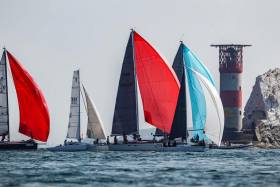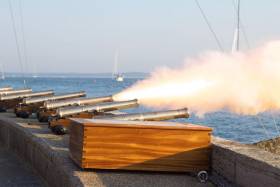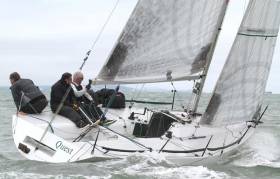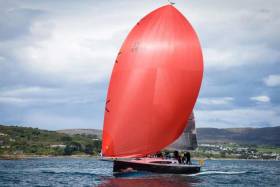Displaying items by tag: Round the Island Race
Line Honours and Gold Roman Bowl for Royal Cork’s Tschüss 2 in 2023 Round the Island Race
Royal Cork Yacht Club members Christian Zugel and wife Sonia Rohan took line honours in Cowes on Saturday (1 July) in this year’s Round the Island Race.
RCYC’s former Olympian Tom McWilliam also featured among the crew of their Volvo 70, Tschüss 2, which was the first monohull to finish in Saturday’s race — and was awarded the Gold Roman Bowl for first place under IRC.
The performance only adds to the pedigree of the boat, which won the 2019 Rolex Fastnet Race as Wizard and the Volvo Ocean Race 2011-12 as Groupama.
The weather conditions could not have been better for Tschüss 2 — a strong breeze throughout the day and from the west enabling a spinnaker run from just before the Needles right the way to Bembridge.
 Tschüss 2’s crew celebrate their line honours and award of the Gold Roman Bowl on arrival in Cowes | Credit: Royal Cork Yacht Club/Facebook
Tschüss 2’s crew celebrate their line honours and award of the Gold Roman Bowl on arrival in Cowes | Credit: Royal Cork Yacht Club/Facebook
Tschüss 2 completed the course in four hours, 11 minutes and 18 seconds with the mini maxi Notorious crossing the line in second place finishing in four hours, 19 minutes and four seconds.
Christian Zugel, owner and skipper of Tschüss 2 said: “We are delighted with our race performance today and securing line honours is fantastic — what better way to start a new programme on our new boat! Great sailing, great competition and a fantastic welcome from the Island Sailing Club.”
Tschüss 2 had been training for more than a week on the Solent and a practice race around the Isle of Wight but they did it clockwise — like the original America’s Cup route in 1851.
The tactician onboard, Neal McDonald said: “I’ve competed in the race a number of times and can say it was perfect conditions for Tschüss 2 today. It’s such an iconic race in a wonderful setting.”
Clockwise or Anti-Clockwise? The Choice Is in Sailors’ Hands as Howth’s Round the Island Race Returns
On Saturday 12 March, ask yourself whether going clockwise or anti-clockwise around Ireland’s Eye will bring you glory — as the Round the Island Race returns after a two-year break.
Supported by Key Capital, sponsors of Howth Yacht Club’s Winter Dinghy Series, the Round the Island Race (not to be confused with the Isle of Wight equivalent) traditionally marks the end of the Frostbite series which, as the offspring of the appearance of the revolutionary Laser dinghy in the 1970s, has now been running for nearly 50 years.
This year’s RTIR will be different, however. In addition to racing for the renamed ILCAs, the RS Aeros will join the fun and other dinghies wanting to get involved can race using the Portsmouth Yardstick (PY) handicap system.
The RS Aero is a modern lightweight single-handed dinghy with a growing fleet based in Howth and they expect to be joined by several visiting class-mates to enjoy the unique experience of racing around an island.
Interest has also been expressed by owners of an RS 800, RS 600, several RS Fevas, 420s and a 470. Boats that have been racing all winter in Dun Laoghaire Harbour and at the other Frostbite venues around the country are particularly welcome to take on the challenge.
Anyone sailing a dinghy, single- or double-handed, with a PY rating and a similar performance to the ILCAs and Aeros is invited to enter for a great day of racing and socialising as the RTIR makes its comeback after a two-year absence.
The winning ILCA usually completes the race in less than an hour and its skipper is the one who has sailed best and successfully resolved the clockwise/anti-clockwise riddle for the day.
Ireland’s Eye is a triangular shape with high ground towards one corner and the tides around it vary in strength and direction depending on time and location. The vagaries of wind and tide have seen many an early leader struggling to salvage a top-10 result – snakes and ladders afloat!
Dinghies already entered for the HYC Frostbite Spring Series get free entry to the event and those who have not can enter online.
The plan for the day is a 9.30am briefing ashore at the HYC race office, a warm-up race (warning signal 10.55am) over a course laid in Howth Sound to get proceedings afloat under way, and then the main event: the expedition around Ireland’s Eye.
The start and finish lines for the RTIR will be in Howth Sound and, between crossing them, the island must be left to port or starboard at each competitor’s discretion.
Lunch and the prize-giving for both the Frostbite Series and RTIR are an option after racing and, to round out a sporting day, the TVs in the clubhouse will show England taking on Ireland in Six Nations rugby at 4.45pm.
The Island Sailing Club put on a spectacular 90th anniversary party for the 2021 Round the Island Race, and there was an excellent turnout of X-Yachts in both the IRC & ISC classes — with some notable silverware won by the Xp 38, Red Five.
The huge fleet of over 1,200 boats showed how much people love taking part in this event. On the water there was everything from flat calm to 25-knot gusts, fog and sun.
And as with every Round the Island Race, nothing compares to the sight of the fleet stretched out around the stunning Isle of Wight coast.
Some of the X-Yachts owners who took park shared their thoughts with the yacht-builder HERE.
Meanwhile, it’s been busy at the half-year mark for X-Yachts in Hamble with five new yacht handovers to delighted owners in June.

The X4⁰ Chirp Chirp II was collected from the yard in Denmark in gorgeous sunny conditions. Her aim was fast comfortable cruising for two, between the UK and Finland, and that looks to be exactly how she has come out, as the owner commented: “She is great, we had a good first sail, boy she knows how to get speed. She has a lovely feel really looking forward to eating up miles next week, we are smiling a lot.”

Pelagia is the name of the X4³ that has been set up for a life in warmer climes, with a while hull and bimini for the sunny Aegean Sea. She is being transported down to Athens now, and will be ready for sailing adventures in the second half of this season.

Another X4³, Onyx II, was specified with a dark grey hull, Flexiteek on deck, a carbon mast and boom — and with the option of longer-distance racing in the future, lithium ion batteries were also specified. The owners commented that their first night on board was A1.

Another boat with impressive dark grey topsides is the X4⁶, Dash, which also has the Flexiteek option on deck and a gorgeous Nordic oak interior. Dash be kept in Hamble and used for family cruising and occasional racing. The owners took her through her paces in the Round the Island Race last weekend with help from X-Yachts’ own Stuart Abernethy as crew.

Last but not least, the Xc 50 Pelagos is specified for true blue-water cruising, with twin forestays for ease of use in all conditions, and air-conditioning and water-maker systems installed for comfortable life aboard. She will winter in Hamble and then sail to the Caribbean before reaching her home on the east coast of the US.
All of these yachts are now being enjoyed by their owners, clocking up many sea miles that they have been dreaming about over the last year during their build — and there are many more to come in the second half of 2021.
If you want to join them, learn more about X-Yachts and possibly view the latest models, follow the links to get in touch with X-Yachts dealers in the UK and Ireland.
Owners please note that the X-Yachts factory in Denmark will be closed for three weeks starting 19 July. During this time X-Yachts will be unable to order any specialist parts for your yacht. If you have any questions or want to order any parts prior, please call +44 (0)23 8045 3377 or email Nick at [email protected]
Peter Cunningham’s PowerPlay Racing Team is the first to finish the 90th edition of the Round the Island Race.
MOD70 PowerPlay, with Peter Cunningham on the helm, finished the race at 10:51:01 BST (09:51:01 UTC) in an elapsed time of 4hrs 11mins 01secs.
A light start to the race prevented any chance of beating the race record, set by PowerPlay, as Concise 10 in 2017 (2hrs 22mins and 23 secs). PowerPlay finished this year's race ahead of the ULTIM Actual and the 32m trimaran IDEC.
 MOD70 PowerPlay crew: Peter Cunningham (Helm), Ned Collier Wakefield (Skipper), Tom Dawson, Miles Seddon, Paul Larsen, Nick Hutton, Frank Gerber, Martin Watts, John Hamilton.
MOD70 PowerPlay crew: Peter Cunningham (Helm), Ned Collier Wakefield (Skipper), Tom Dawson, Miles Seddon, Paul Larsen, Nick Hutton, Frank Gerber, Martin Watts, John Hamilton.
Britain's Round the Island Race Celebrates 90 Years on July 3
Entries for the world-famous Round the Island Race opened at 00.01 this morning, 19 March. Organised by the much-respected Island Sailing Club, the Round the Island has always been one of the UK’s largest participation sporting events and regularly attracts over 1,500 boats and thousands of sailors. This year the race will be held on 3 July and celebrates its 90th anniversary, and with so many high-profile events being cancelled, the Round the Island is being tipped as one of the biggest events to be staged since the UK’s first lockdown a year ago.
One of the unique attractions of the race is its even-handedness and the opportunity for Olympic and World champion sailors to compete on the same racecourse with amateurs, families and club sailors of all ages. Whilst the majority of the boats will simply enjoy the challenge of getting all the way round, there will be many teams aiming to beat the existing course records. The current monohull record continues to be held by Mike Slade on ICAP Leopard, who in the near-perfect conditions of 2013 posted an elapsed time of 3 hours 43 minutes and 50 seconds. The multihull class, introduced in 1961, generally achieves even faster times, as shown in 2017 when Ned Collier Wakefield’s Concise10 flew round in just 2 hours 22 minutes and 23 seconds.
Rob Peace, Rear Commodore for Sailing, ISC said “The Island Sailing Club are delighted to launch the 2021 Race. Sailors are desperate to get back out on their boats, and our race is perfectly timed and definitely provides a unique and thrilling experience for all of the crews. Over the past 90 years approximately 500,000 sailors and 70,000 boats have been challenged by this race - those are some impressive statistics!”
David Atkinson, Race Director said “The focus for 2021 is on organising a great race on the water. While the UK Government's roadmap out of lockdown suggests we will be able to run some of our usual social activities ashore, we are very mindful of the possible need to avoid large gatherings over the race weekend. No decisions have been taken at this stage, and we will be updating our plans in line with the easing of restrictions over the coming weeks and months. Naturally, we expect those taking part to follow all of the current guidelines in place for the race, and we will be providing a summary of guidance from relevant authorities through a dedicated page on the event website. We will be asking everyone to check this regularly, familiarise themselves with the information and help make the event safe for us all.”
The ethos of a ‘Race for All’ continues at pace this year with the first Windeler Cup competition to set sail after the main fleet departs from Cowes, allowing small keelboat racers from the Daring, Dragon, Etchells, Flying Fifteen, Mermaid, Redwing, Sunbeam, Swallow, Sonar, Squib, RS Elite, Victory and XOD classes to join in the fun with an exciting Solent Race. Also, the race weekend is extended to welcome competitors from the rowing and kitesurfing worlds, who will enjoy their own Round the Island on the Thursday and Friday before the main sailing race on Saturday 3 July.
Local boat Eeyore, an Alacrity 18 Bilge Keel from Cowes, has laid claim to the prestigious Gold Roman Bowl, winning this year’s Round the Island Race after a long tactical day on the water.
With a crew of just three: skipper Joe Richards and his friends David Rickard and Duncan De Boltz, the 18-foot bilge keel was the smallest boat in the race.
A member of Gurnard Sailing Club and Cowes Corinthian, Richards talks through his winning race: “It was an interesting but long race, we actually started at the opposite end of the line from the rest of the fleet which paid us reasonably well in the end. We got down to The Needles middle of the fleet and then there was almost no wind. We bounced off a couple of rocks on The Needles just for good measure and then it’s tempting to stay out of the tide and we did a couple of little tacks and thought no we need to be strong minded and go out, because you always get a wind bend down off Freshwater and if you sail along under the cliffs it just leaves you in a hole eventually.
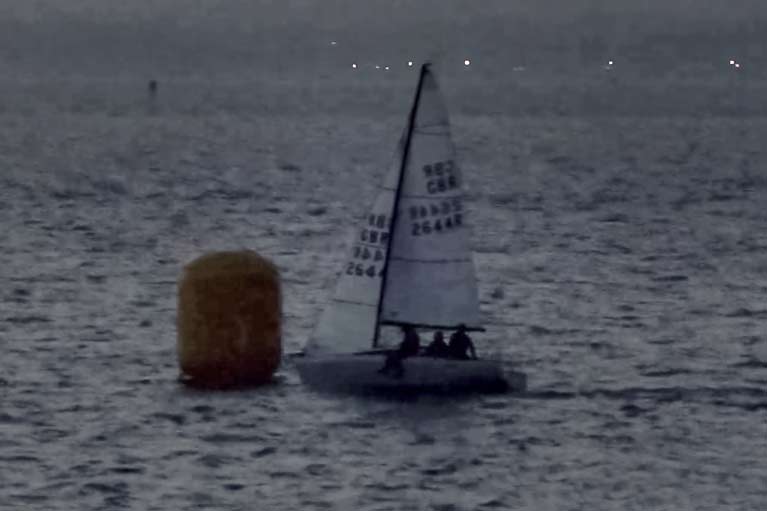 Small boat - Eeyore, the modest Alacrity 18 bilge eeler, has won the prestigious Round the Island Race (and, yes, this is the only picture we could find!)
Small boat - Eeyore, the modest Alacrity 18 bilge eeler, has won the prestigious Round the Island Race (and, yes, this is the only picture we could find!)
After competing in the Round the Island Race more times than he can remember and with two seconds already under his belt, Richards comments on his win: ”It’s probably about time too isn’t it? We’ve been second a couple of times over the years but the reality is there are some very good sailors out there and very good boats; you’ve got to be lucky and get the breaks. Unless you’ve done the preparation and put yourself in a position to get the breaks it doesn’t happen, but you do still have to be lucky.”
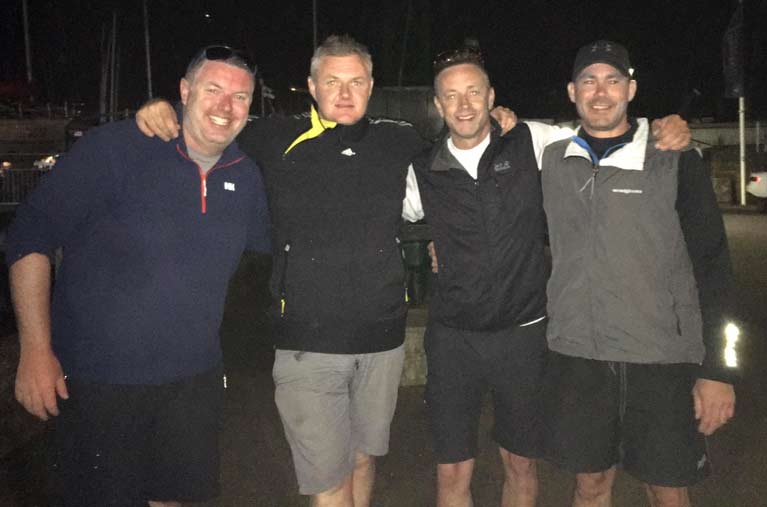 A Cove Sailing boat crew (pictured above after the finish last night), Wicked Wookie, a hunter Sonata (skippered by Jason Losty), was fifth overall in the Round the Island race
A Cove Sailing boat crew (pictured above after the finish last night), Wicked Wookie, a hunter Sonata (skippered by Jason Losty), was fifth overall in the Round the Island race
The race offered challenging sailing conditions for the crew of Eeyore, which circumnavigated the Isle of Wight in 13 hours, 36 minutes and 31 seconds. The fleet of over 1,200 entries contended with fluctuating wind speeds from every direction, with only 257 boats completing the race before the 10.30pm deadline.
The first finisher (with a time of 7 hours, 33 minutes and 36 seconds) was Yves Le Blevec’s Graghjghnd Prix racing multihull – ‘Actual Leader’ which led for much of the race. In light to moderate winds she managed to shake off her closest on-the-water rivals – Jethou, Ino XXX, Lady Mariposa and Mini Y.
A delighted Le Blevec (53) from La Trinite Sur Mer, commenting on a long, but exciting day on the race course just before he set sail back to La Trinite Sur Mer, said: “I really enjoyed the race, I always enjoy sailing here and it was great to have taken line honours. This is now my fourth time competing here but in this boat it was tricky. We stayed in the same place for two or three hours off Ventnor in no wind, which was frustrating. ‘Actual’ is designed as a round the world boat not for Round the Island Race. It is very difficult to manage tacking or gybing so often, so we are pleased to have done so well today.”
The award for the first monohull across the line, at 16:30:28 (taking 9 hours and 28 seconds), went to Sir Peter Ogden’s Judel Vrolijk Mini Maxi ‘Jethou’ which almost snatched the lead from ‘Actual Leader’ earlier in the day. Despite hitting the bottom and hooking a lobster pot the crew of ‘Jethou’ had a great race with owner, Sir Peter Ogden, commenting: “Our top speed was 20knts which was 2 minutes after the start, but it went downhill after that and we averaged 7.9knts over the course. The best sail of the day was the stretch from the forts to the finish where we enjoyed a really nice breeze.”
This year’s race saw thousands of sailors compete on over 1,200 yachts in one of the UK’s largest sporting events. The Round the Island Race is a true race for all with competitors enjoying a spinnaker start for the first time in almost ten years.
Commodore of the Island Sailing Club, David Atkinson said: “It's been a difficult day, we started in such great conditions in the morning with the wind doing exactly what we thought it would but as the day progressed the wind became increasingly unpredictable. One example was at St Catherine’s Point where one side there was 15knts of breeze, but just around the corner, half a mile away only 5-6knts of breeze from a totally different direction. Tactically today it was difficult because the wind was all over the show.
“But the competitors have been terrific, with lots of feedback on what a lovely day people have had on the water despite the wind. Someone said to me anyone can sail in a reasonably good, steady breeze but when you have to tactically think about the wind, the tides and everything else in order to make your boat go, that can make it really interesting.
“I’d like to thank all the competitors for making this a fantastic event, the new Official Race Village has gone down well and had a real buzz around it and now we’re looking forward to the prize giving tomorrow and welcoming people back again next year on 30th May 2020.”
British Sailing Team and official Round the Island Race Meteorologist, Simon Rowell, commented: “The weather today was set up for a good quick run down to The Needles, then once the fleet got through The Needles they were beating back up to St Catherine’s Point, still in a reasonable amount of breeze so that worked out OK.
“Then in the very hot afternoon, the warm air bubbling up off the island killed the breeze for quite a long way offshore, going from St Cat’s round to Bembridge. With some filling in, it did go round to the right as we were expecting with the forecast, and its now coming in nicely from the west southwest; but there was a very slow 3 or 4 hours for quite a few boats going round the south-east side of the Isle of Wight. The boats that did really well, especially the winner, managed to catch it very well and were just ahead of the light stuff on the south-east of the Island and managed to have a good run right to the finish.”
Michael Kitchen, actor, television producer and competitor, was the official race starter of the 88th Round the Island Race. Known particularly for his role as Detective Chief Superintendent Christopher Foyle in the ITV drama series Foyle’s War he said: “I couldn’t feel more honoured with the invitation of the official starter of this iconic race. It is a huge privilege. I have competed at the event many times and we always have a cracking time. It is a brilliant event.”
In what will probably be regarded as one of the most challenging on record, the 87th edition of the Round the Island Race was won overall by High Potential with the top Irish result from the four boats competing coming from Barry Cunningham's Quarter Tonner Quest in 25th place from 1204 starters.
Mayo Sailing Club's 'Xstatic', a regular WIORA competitor, skippered by Damien Cashin was slated to start as was the Royal Irish Yacht Club's 'Jib and Tonic' from Dublin Bay skippered by Morgan Crowe. Cunningham's entry had Prof O'Connell on board. Altair, a Beneteau 36.7, from Cove Sailing Club in Cork Harbour was also competing and Vendee Globe campaigner Nin O'Leary, who raced to success in last year's race was back again racing onboard Adam Gosling's new Yes! boat. See full results here.
Ross Applebey and his team, based in Lymington, sailed an impressive race in the light, tactical conditions and after 8:30:03 was deemed the overall winner of the Gold Roman Bowl on corrected time.
Commenting on his team's win of the Gold Roman Bowl, an elated skipper said:
"We are absolutely delighted with the result! It's been an amazing day of sailing and, this year, everything we did seemed to turn to gold with things ultimately turning in our favour as we approached Ryde. We've had a great atmosphere on board all day with my wife, Sarah, and our good friends. After doing a dozen or so Round the Island Races in the past, and the last three of those in High Potential, we are so happy that our hard work has paid off."
Ned Collier Wakefield, alongside Irvine Laidlaw, sailing aboard Tony Lawson's MOD70 foiling trimaran Concise Fling – was fairly accurate in his prediction to record the slowest time for line honours. It may not be official but 8:34:09 (over six hours more than it took last year when they broke the multihull record) is definitely up for debate.
The general lack of wind and seabreeze that failed to materialise, left hundreds of teams struggling to reach the Needles before the tidal gate slammed shut in the early part of the race. Those who sneaked through had little option other than to soldier on and endure a slow, challenging, and extremely hot rounding.
The award for the first monohull to finish went to Tony Langley's TP52 Gladiator who completed the course with an elapsed time of 8:56:47. Chatting after the race, Langley said: "It was the longest one I've ever done; nine hours on the helm which is plenty.
"There were three transitions, two round the back of the Island, and one on the eastern Solent. These transitions from one breeze to the other were the tricky ones; a knot or so of wind, so it was a case of just keeping the boat working to get through to the new breeze."
Commenting on their efforts to catch Concise Fling on the final stretch to the finish line, Langley added: "We didn't quite make it but we did have a moment when we thought we might do because they were in the transition for a lot longer."
Mention should also be made of the winner of Raymarine Live Weather Briefing, prize draw. Paul French from the Westerly Regatta 290, Temptation was the lucky winner of the Raymarine Axiom 9 inch and the new AIS700 – total value £2,390.
For full results, click here. Prizes will be presented at the Round the Island Race prizegiving ceremony tomorrow (8 July) at Island Sailing Club.
Round The Island Racing Close Throughout The Fleet - Apart From Record-Breaking ‘Concise Fling’
There may be little wind on the racecourse for the 1,200 or so teams contesting Island Sailing Club’s annual 50nm race around the Isle of Wight, but there is certainly no shortage of competitive spirit.
Racing is close throughout the fleet apart from Tony Lawson’s record-breaking five-year-old MOD70 foiling trimaran Concise Fling that broke away from the pack at the Needles, rounded St Catherine’s Point, and as of an hour ago was tracking along up the east coast towards Bembridge, alone.
Even in the expected light winds of just 10 knots, this crazy machine can reach 35kts of boat speed, so whatever the weather there are generally always plenty of thrills to be had aboard this boat.
The bulk of the fleet, however, was enjoying a tactical game of cat-and-mouse down the west coast of the Island. Jennifer Burgis and the all-female team who raced the 2015-16 Clipper Round the World Race are today sailing Fleur de Lis, a chartered Beneteau Oceanis 37, and are currently sailing an impressive race. Importantly, they managed to reach the Needles before the tide turned.
Burgis commented from the racecourse: “Despite the lack of wind we are extremely pleased with our progress. It took us just two hours to get to the Needles. We had a great start with Holly [Kitching] on the helm and Caroline Bowen on tactics, which was key and, we are looking forward to continuing to work hard and gain more places as we head down the west coast.
“We are really pleased because we seem to have caught up with the Turquoise flagged group that started 10 minutes ahead of us. I think we can put our impressive speed down to Caroline Bowen our tactician who is calling some really good shots in these tricky conditions.”
Although the sea breeze should have now filled in, it is generally slow going. More than half the fleet is round the Needles but the race was on for those struggling to reach that point before the tide turned at 11.30am.
Even if the cloud builds on land and sea breeze does develop, it is unlikely to be significant. Around the top of the Island from Bembridge Ledge to Ryde — the lee of the island — will be one of the biggest areas of concern and a lot of places were likely to be won and lost there. See the Race Tracker for more.
With the Round Ireland Race over, the focus for the winning boat Baraka GP plus four Irish boats is now on this weekend's Round the Island Race on the Solent and attention has turned to the weather forecast and, in particular, a low off Lands End.
As Afloat.ie previously reported there will be four Irish entries among a flurry of international entries to sign up for the 50nm sail round the Isle of Wight tomorrow.
Mayo Sailing Club's 'Xstatic', a regular WIORA competitor, skippered by Damien Cashin will be on the start line as will the Royal Irish Yacht Club's 'Jib and Tonic' from Dublin Bay skippered by Morgan Crowe. The latest entry is the top flight Quarter Tonner Quest, skippered by Barry Cunningham, also from the RIYC. Prof O'Connell, who was aboard Chris Power Smith's second overall Aurelia in the Round Ireland Race, is racing on Quest in a busy week for the sailing professional. Altair, a Beneteau 36.7, from Cove Sailing Club in Cork Harbour is also competing and Vendee Globe campaigner Nin O'Leary, who raced to success in last year's race is back again racing onboard Adam Gosling's new Yes! boat.
A high should move over the UK bringing a light N/NW gradient wind. It should be a hot & sunny day, allowing the heat low to develop again over the E of England. As it does so the breeze should back left WSW up the Channel, remaining quite light.
For Saturday the high should be firmly settled over the UK with its central ridge extending from S of Ireland to around Newcastle. This will bring a hot & sunny day with a light NNE/NE gradient wind to start. This is likely to be replaced by a developing sea breeze around 1100, light S/SSW around the back of the Island, light SSE/SSW through the E Solent. It will be a very tactical day.
Gusts are likely to be 1/3 as much again as the average wind speed. Squall-driven gusts may be higher still - the deeper the cloud, the stronger the gust.
RACE DAY - Saturday 7th
Light NE 4-7 kts to start, going very light & patchy then returning S/SSE 6-10 kts around noon veering right SSW 6-10 kts around the back of the Island. In the E Solent, this is likely to be SE/SSE 5-9 kts through the afternoon. It's going to be hot & sunny, with significant local thermal effects.
Met Office: NE 5-8 kts, dying around 1100, settling back in S/SSW 5-9 kts afternoon.
ECMWF: N 3-6 kts then SW 6-10 kts.
NOAA's GFS model: N 3-6 kts in the morning, then SW 6-10 kts.
Three Irish entries are among a flurry of international entries to sign up for the 50nm blast round the Isle of Wight next month.
With less than three weeks to go until the start of Round the Island Race 2018 on 7 July, entries are starting to flow in with numbers almost at the 1,000 mark. Equally encouraging is the fact that international entries are on the rise too with a total of 23 teams already signed up.
Mayo Sailing Club's 'Xstatic', a regular WIORA competitor, skippered by Damien Cashin will be on the start line as will the Royal Irish Yacht Club's 'Jib and Tonic' from Dublin Bay skippered by Morgan Crowe. The latest entry is the top flight Quarter Tonner Quest, skippered by Barry Cunningham, also from the RIYC, that is currently placed eighth at the Quarter Ton Cup in Cowes.
Cashin's Xstatic, however, is not his usual X42 but a new X49 yacht. The full Mayo Sailing Club crew pick up the new marque in X Yachts in Denmark next week and sail straight for the Isle of Wight race, according to crewman, Joe McGovern.
This annual, world-recognised race organised by Island Sailing Club, is one of those must do, quintessential English regattas, that competitors travel thousands of miles to compete in.
As well as the huge numbers that take part, it is the diversity of the fleet that ranges from high profile race teams to weekend club sailors that makes this annual 50nm blast round the Isle of Wight so special.
While most of the international entries signed up so far are based in Europe including Belgium, France, Germany Ireland, Italy, and The Netherlands, the organisers are delighted to welcome Charlene Howard and her team from the USA sailing AJ Wanderlust (Jeanneau 45.2).
Organisers are also pleased to welcome back Dr Benic Hervé and team from France who, racing their Beneteau First 40 Iritis, not only finished in a creditable fourth place in IRC overall, and third in IRC 1 last year, but were also the leading international team.
So far France makes up the bulk of the international contingent with a total of 10 boats but with just over 20 days to go before race day, there is still time for Belgium or The Netherlands, currently lying second in the international entry rankings, to put paid to the current French domination.




























